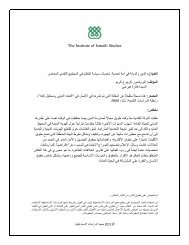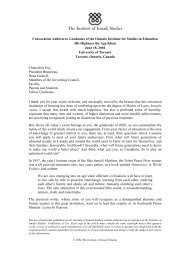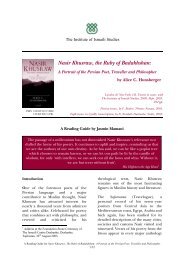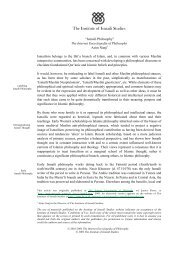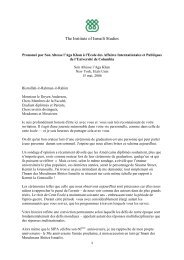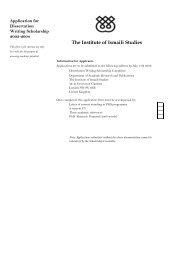The Institute of Ismaili Studies 1
The Institute of Ismaili Studies 1
The Institute of Ismaili Studies 1
Create successful ePaper yourself
Turn your PDF publications into a flip-book with our unique Google optimized e-Paper software.
institution <strong>of</strong> learning founded by the Fatimids was the Dar al-‘Ilm, the House <strong>of</strong> Knowledge,<br />
sometimes also called Dar al-Hikma. Established in 395 AH/ 1005 CE by the Caliph-imam al-Hakim<br />
(386-411 AH/996-1021 CE), a variety <strong>of</strong> religious and non-religious subjects were taught here and it<br />
was also equipped with a major library. Many Fatimid da‘is received at least part <strong>of</strong> their training at<br />
the Dar al-‘Ilm (Maqrizi, al-Khitat, I, pp. 458-60; Halm, 1997, pp. 71-77; Walker, 1997, pp. 189-93).<br />
Information on the structure and functioning <strong>of</strong> the <strong>Ismaili</strong> da‘wa organisation was among the most<br />
guarded secrets <strong>of</strong> <strong>Ismaili</strong>sm. <strong>The</strong> religio-political messages <strong>of</strong> the da‘wa were disseminated by<br />
networks <strong>of</strong> da‘is within the Fatimid dominions as well as in other regions referred to as the jaza’ir<br />
(singular, jazira, “island”). Each jazira was placed under the charge <strong>of</strong> a high-ranking da‘i referred to<br />
as hujja; and every hujja had a number <strong>of</strong> da‘is <strong>of</strong> different ranks working under him. Organised in a<br />
strictly hierarchical manner, the Fatimid da‘wa was under the overall supervision <strong>of</strong> the imam and the<br />
da‘i al-du‘at, or bab, who acted as its administrative head. <strong>The</strong> da‘wa organisation developed over<br />
time and reached its full elaboration under the Caliph-imam al-Mustansir (see Daftary, “Da‘i,” in EIr,<br />
VI, pp. 590-92; — —, 1990, pp. 224-32; Stern, 1972, pp. 437-50; Hamdani, 1976, pp. 85-114). It was<br />
in non-Fatimid regions, in the jaza’ir, especially Yemen, Persia and Central Asia, that the Fatimid<br />
da‘wa achieved lasting success (Daftary, 1999, pp. 29-43; — —, “Medieval <strong>Ismaili</strong>s,” pp. 48-61). <strong>The</strong><br />
da‘wa was intensified in Iraq and Persia under Caliph-imam al-Hakim. Foremost among the da‘is <strong>of</strong><br />
this period was Hamid al-Din Kirmani. A learned philosopher, he harmonised <strong>Ismaili</strong> theology with a<br />
variety <strong>of</strong> philosophical traditions in developing his own metaphysical system. In fact, Kirmani’s<br />
thought represents a unique tradition within the Iranian school <strong>of</strong> philosophical <strong>Ismaili</strong>sm. He<br />
expounded a particular cosmology, replacing the Neoplatonic dyad <strong>of</strong> intellect and soul in the spiritual<br />
world by a system <strong>of</strong> ten separate intellects in partial adaptation <strong>of</strong> Farabi’s Aristotelian cosmic<br />
system (Kirmani, Rahat al-‘aql, pp. 134 ff.) Kirmani’s cosmology was not adopted by the Fatimid<br />
da‘wa; it later provided the basis for the fourth and final stage in the evolution <strong>of</strong> <strong>Ismaili</strong> cosmology<br />
at the hands <strong>of</strong> Tayyibi Musta‘li da‘is <strong>of</strong> Yemen (see W. Madelung, “Cosmogony and Cosmology in<br />
<strong>Ismaili</strong>sm,” in EIr, VI, pp. 323-24; de Smet, 1995, pp. 16-377; Walker, 1999, pp. 80-117). Imam al-<br />
Hakim’s reign also coincided with the initial phase <strong>of</strong> what was to become known as the Druze<br />
religion, founded by a number <strong>of</strong> da‘is who had come to Cairo from Persia and Central Asia, notably<br />
Akram, Hamza, and Darzi. <strong>The</strong>se da‘is proclaimed the end <strong>of</strong> the era <strong>of</strong> Islam and declared the<br />
divinity <strong>of</strong> Imam al-Hakim. Kirmani was <strong>of</strong>ficially invited to Cairo around 405AH/1014CE to refute<br />
the new extremist doctrines from a theological perspective (M. G. S. Hodgson, “Duruz,” in EI2, II,<br />
pp. 631-34; Bryer).<br />
<strong>The</strong> <strong>Ismaili</strong> da‘wa activities outside the Fatimid dominions reached their peak in the long reign <strong>of</strong><br />
Imam al-Mustansir (427-487 AH/1036-1094 CE), even after the Sunni Saljuqs had replaced the Shi‘i<br />
Buyids as overlords <strong>of</strong> the Abbasids in 447 AH/1055 CE. <strong>The</strong> Fatimid da‘is won many converts in<br />
Iraq and different parts <strong>of</strong> Persia and Central Asia. One <strong>of</strong> the most prominent da‘is <strong>of</strong> this period was<br />
al-Mu’ayyid fi’l-Din Shirazi who, after his initial career in Fars, settled in Cairo and played an active<br />
role in the affairs <strong>of</strong> the Fatimid dawla and <strong>Ismaili</strong> da‘wa. In 450 AH/ 1058 CE, Imam al-Mustansir<br />
appointed him as da‘i al-du‘at, a post he held for twenty years, with the exception <strong>of</strong> a brief period,<br />
until his death in 470 AH/1078 CE (see al-Mu’ayyid fi’l-Din, Sirat; Klemm, pp. 2-63, 136-92). Al-<br />
Mu’ayyid established closer relations between Cairo and several jaziras, especially Yemen where<br />
<strong>Ismaili</strong>sm had persisted in a dormant form throughout the 4th/10th century. By the time <strong>of</strong> Imam al-<br />
Mustansir, the leadership <strong>of</strong> the da‘wa in Yemen had fallen into the hands <strong>of</strong> the da‘i ‘Ali b.<br />
Muhammad al-Sulayhi, an important chieftain <strong>of</strong> the Banu Hamdan in the mountainous region <strong>of</strong><br />
Haraz. ‘Ali al-Sulayhi rose in Haraz in 439 AH/1047 CE, marking the effective foundation <strong>of</strong> the<br />
Sulayhid dynasty ruling over different parts <strong>of</strong> Yemen as vassals <strong>of</strong> the Fatimids until 532 AH/1138<br />
…Please see copyright restrictions on page 1<br />
9



